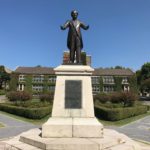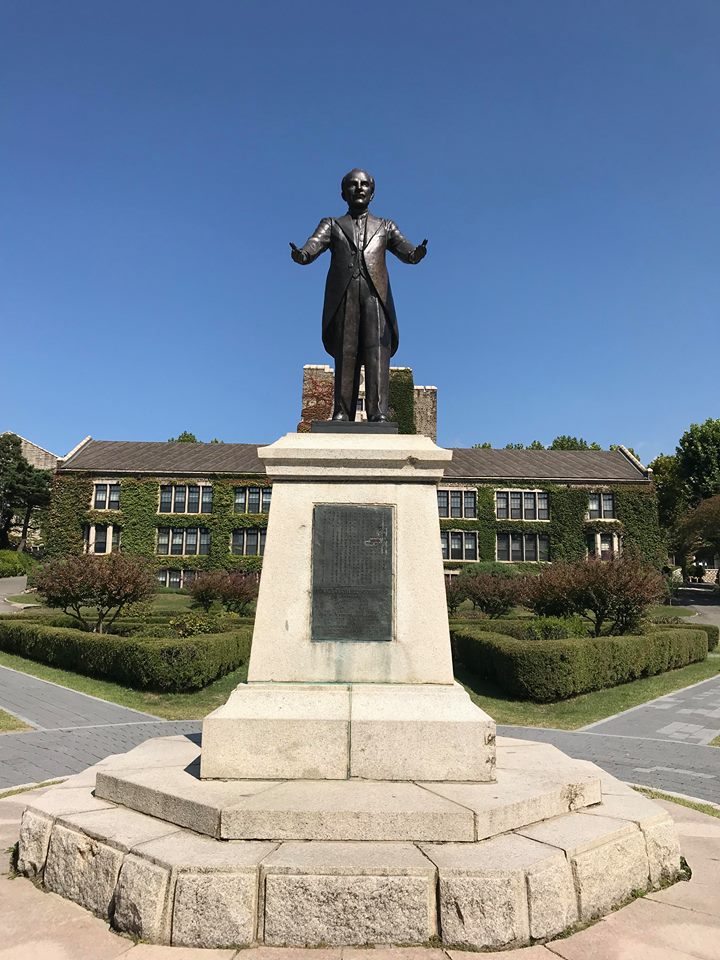Editor’s Note: This piece opens a SEAA column themed series on “Cultural Consumption and Performance in Asia.” The articles highlight different aspects of consumption and performance in a range of Asian regions. They examine issues such as cultural curation, the uses of the past, material culture, power and market, as well as the enactment of lived experience.
While assisting with a campus tour of Seoul’s Yonsei University in the summer of 2008 for a group of American social studies teachers, the Korean-graduate-student-turned-tour-guide stopped in front of the famed statue of Yonsei’s founder, Horace Underwood. The graduate student explained that the statue, first erected in 1916, was destroyed during the Korean War (1950–1953) when North Korea took Seoul and used Yonsei’s campus as a base of operations. The only part of the statue that remained was the base, he said, pointing to it and the discoloring that indicated soot and ash. Fervently, the teachers began taking pictures of the statue’s base and discoloring, as if to photograph a site of “history.”
Why is the base of the statue so fascinating for these American teachers, and why did the graduate student find this story interesting enough to share in the first place? Echoes of the Korean War adorn the landscapes of Seoul and South Korea. Some are more spectacular, like the De-Militarized Zone; but most are just ordinary sites akin to the statue’s base. These historical markers, however, represent not only a finite period of active war between 1950 and 1953, but the long durée of Cold War militarization on the peninsula. Sites like the statue’s base are temporal markers of past destruction that simultaneously remind us of the possibility of future catastrophe. Yet these temporal markers rely on active recognition as a site of war, incursion, or security. Curating these sites thus calls forth their past, but the interest and fascination lie not only in what happened in that place at that time, but in the proximity and potentiality of future peninsular destruction. The fascination and interest in the sites—and indeed, the curation itself—are part and parcel of the banality of militarization borne of Cold War insecurities of national destruction. At a time when it seems that North-South relations are substantially improving, it is crucial to recognize the power and pervasiveness of militarization that encourages Koreans to tell stories of sites like the statue’s base and the audience’s fascination is violently etched and burned into the physical landscape of the peninsula.
The unending
This is the unending not only of a war or permanent confrontation, but also of spaces and objects that simultaneously remind us of disaster while compelling us to forget, only to be repeated infinitely.
The banality of continued militarization depends first on what some call the “unending Korean war” (Hong 2015). While the 1953 Korean Armistice Agreement ceased active combat, North and South Korea are still officially at war. This permanent confrontation provides the South Korean state with justification for continued military conscription of all able-bodied men and the violent and undemocratic policies and actions of former authoritarian leaders Park Chung-hee (1961–1979) and Chun Doo-hwan (1980–1987). The constant fear of yet another North Korean incursion or attack, evidenced by, for instance, North Korea’s artillery shelling of Yeonpyeong Island in November 2010, naturalized the on-going confrontation and made banal South Korean responses and precautions. That banality of militarization seeps into the built environment, in part because the state built safeguards for a potential North Korean invasion into urban infrastructure, including overpasses that could fall onto roads to prevent tanks from rolling into Seoul.
Fear and the banality of militarization are also well-adapted to the art of forgetting or even misdirection. While taking Korean language at Sogang University, we read and discussed the Bugak Mountain Fortress Path. Bugak Mountain sits in the northern part of Seoul and the Fortress Path is a popular walking or hiking trail for Koreans and tourists alike. The description in Sogang’s textbook includes the many sites to see along the path, including a more than 200-year-old pine tree with several bullet holes. The textbook explains that on January 21, 1968, several North Korean spies infiltrated South Korea with the intent of making it to the Blue House, the presidential resident, before they were killed by South Korean soldiers (known as the Blue House Raid). The military limited public access to this area for more than 40 years, but now it is part of the popular hiking trail. Yet the tree still acts as a temporal marker, a reminder of past incursion and the possibility for future attack. This is the unending not only of a war or permanent confrontation, but also of spaces and objects that simultaneously remind us of disaster while compelling us to forget, only to be repeated infinitely.
On curation
These sites of peninsular destruction are not limited to sites from the Korean War or North Korean incursions. In 2005, construction workers uncovered an underground bunker in the Yeouido neighborhood of Seoul. There were no records of a bunker in the Seoul Metropolitan Government archives, but experts were able to determine that the bunker was built between late 1976 and early 1977 when inter-Korean tensions were high. Furthermore, given the placement of the bunker, the city government believes that former president Park Chung-hee and his government built the bunker should armed conflict reignite. On October 1, 2015, the city government opened the bunker to the media for the first time, and from October 10 to November 1, public visitors were able to schedule tours of the bunker (Eum 2015). On October 19, 2017, the bunker reopened under control of the Seoul Museum of Art as the SeMA Bunker, showcasing exhibitions that speak to the space’s history and significance (Yoon 2017).
This bunker was a preparatory space, one that never saw its intended use fulfilled, but now acts as a curated reminder of that preparation. Each space and object are historical markers, but are only made so upon curation. In each case—the statue’s base, bullet-laden pine, bunker—curators, broadly conceived, asked audiences to remember a period of war, North-South tension, and security protocols indexed by the object or space. Silently, though, we also remember the possibility of future North Korean belligerence, thus imbuing these historical markers with a future-looking temporality that make them even more fascinating. In that fascination, though, the sleight-of-hand of militarization’s banality takes hold, as we forget that militarization orients people towards violence.
Timothy Gitzen is an anthropologist and Korea Foundation Postdoctoral Fellow in the Institute for Korean Studies at Indiana University. His research focuses on national security, militarization, and queer activism in South Korea. His work has appeared in TSQ: Transgender Studies Quarterly and the forthcoming Duke University Press volume Queer Korea.
Cite as: Gitzen, Timothy. 2018. “Curating Peninsular Destruction.” Anthropology News website, November 28, 2018. DOI: 10.1111/AN.1045
If you want to submit your essay ideas to us, please contact Shuang Frost (shuanglu@fas.harvard.edu) and Heidi Lam (heidi.lam@yale.edu).


